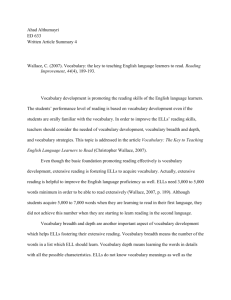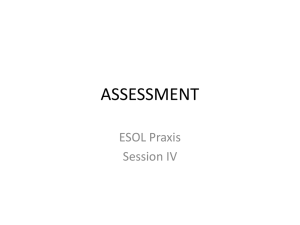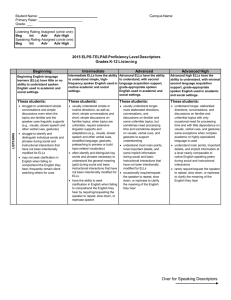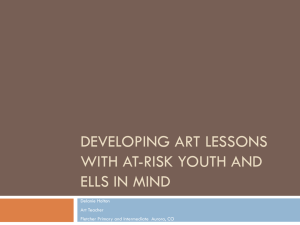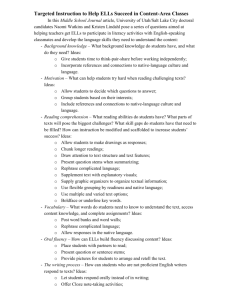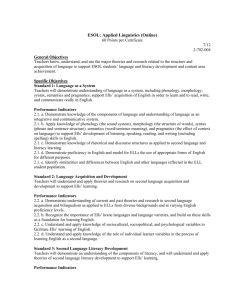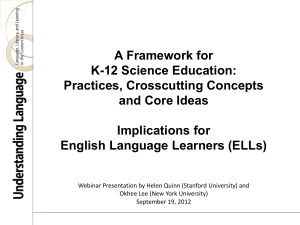Using Visual Arts and Behavior Techniques in the Art Classroom to
advertisement
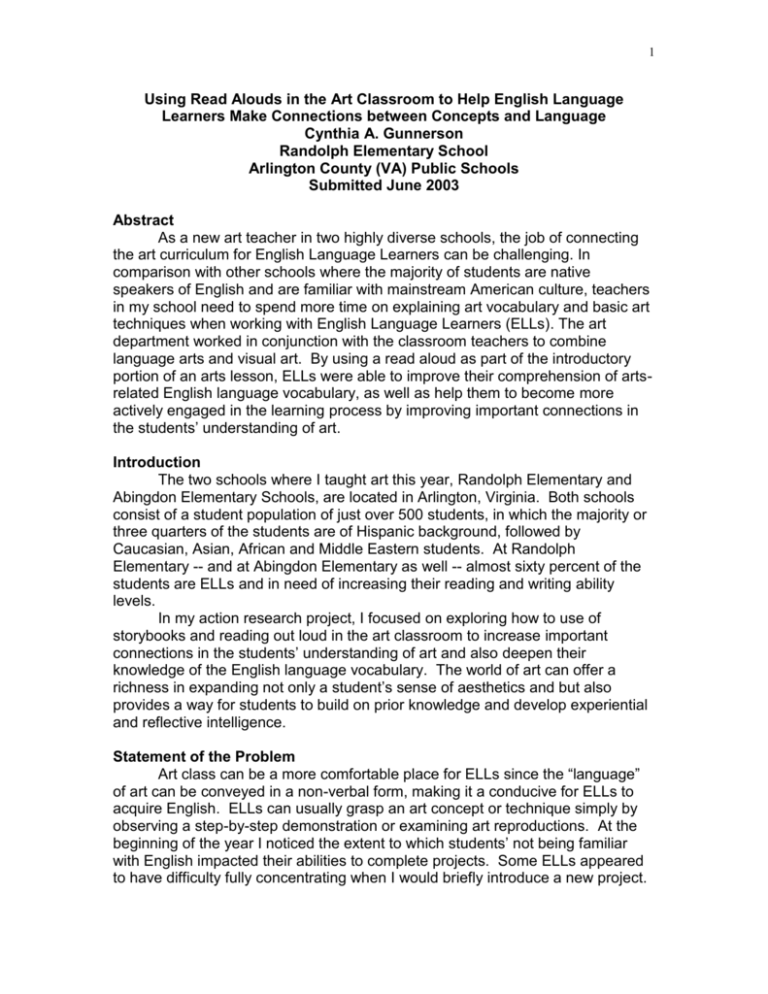
1 Using Read Alouds in the Art Classroom to Help English Language Learners Make Connections between Concepts and Language Cynthia A. Gunnerson Randolph Elementary School Arlington County (VA) Public Schools Submitted June 2003 Abstract As a new art teacher in two highly diverse schools, the job of connecting the art curriculum for English Language Learners can be challenging. In comparison with other schools where the majority of students are native speakers of English and are familiar with mainstream American culture, teachers in my school need to spend more time on explaining art vocabulary and basic art techniques when working with English Language Learners (ELLs). The art department worked in conjunction with the classroom teachers to combine language arts and visual art. By using a read aloud as part of the introductory portion of an arts lesson, ELLs were able to improve their comprehension of artsrelated English language vocabulary, as well as help them to become more actively engaged in the learning process by improving important connections in the students’ understanding of art. Introduction The two schools where I taught art this year, Randolph Elementary and Abingdon Elementary Schools, are located in Arlington, Virginia. Both schools consist of a student population of just over 500 students, in which the majority or three quarters of the students are of Hispanic background, followed by Caucasian, Asian, African and Middle Eastern students. At Randolph Elementary -- and at Abingdon Elementary as well -- almost sixty percent of the students are ELLs and in need of increasing their reading and writing ability levels. In my action research project, I focused on exploring how to use of storybooks and reading out loud in the art classroom to increase important connections in the students’ understanding of art and also deepen their knowledge of the English language vocabulary. The world of art can offer a richness in expanding not only a student’s sense of aesthetics and but also provides a way for students to build on prior knowledge and develop experiential and reflective intelligence. Statement of the Problem Art class can be a more comfortable place for ELLs since the “language” of art can be conveyed in a non-verbal form, making it a conducive for ELLs to acquire English. ELLs can usually grasp an art concept or technique simply by observing a step-by-step demonstration or examining art reproductions. At the beginning of the year I noticed the extent to which students’ not being familiar with English impacted their abilities to complete projects. Some ELLs appeared to have difficulty fully concentrating when I would briefly introduce a new project. 2 Others had difficulty in remembering art vocabulary words that I felt they should know when attempting to ask or respond to questions. When I questioned them I felt that they had only understood the purpose and directions for the task in the very general sense. While the majority of the students would be able to settle down into their projects immediately after the demonstration and verbal introduction for that day’s project, I noticed a difference during clean-up time at the end of class. At this point, many students appeared slow at following directions that were only verbally presented to them. Not surprisingly, when I gave the directions a second time in Spanish they gave me their attention immediately and without hesitation proceeded to the appropriate task. The Research Process When I began my action research project, I asked myself, What can I do to ELLs understand the vocabulary I was using during art class? What can I do to cultivate a richness of knowledge that would assist the students in making more meaningful connections with art and the world around them? I was interested in seeing if this would not only increase my student’s comprehension and concentration while working on their project, but increase their use of vocabulary. Additionally, I wanted to see this would affect their auralverbal comprehension when I was explaining or giving directions in class. The process and strategies that I use in the art classroom include a verbal introduction with visual examples followed by a demonstration. I decided add reading a story book a storybook that interfaced with the current art project at the beginning of class Before I began reading, students predicted from the art on the cover of the book what the story would be about and as I paused at different points of the book asking them to guess what might happen next. During the reading, I used several strategies such as verbal and non-verbal dramatizing such as changing the pitch of my voice, encouraging students to react verbally to events in the story, and engaging students in inquiry. Interestingly, students sometimes reacted by inserting themselves or another student into the story or attempted to give the story a different twist of their own. This engaged the students in dialogue with some use of new vocabulary. Additionally, students were asked to compare a variety of works by different artists, including the illustrators of the books we read in class. In addition, I included some books with text that had Spanish vocabulary that I felt would help my students make the bridge between both cultures and increase their enthusiasm for learning about art history and production. This also seemed to strengthen the confidence of the ELLs to share relevant information with the rest of the class. Students also enjoyed reading aloud to the rest of the class at the end of class. Additionally, I decided to place an increased emphasis 3 on the understanding of important vocabulary words related to the text and also began to draw more frequently on student’s prior experiences and knowledge. New vocabulary was introduced to better define art techniques, and make historical and multicultural connections. As I continued to use books for artrelated projects and ideas, I made greater use of visual aids and written information on art history which I added to our boards. I could see the children probing these aids for meaning and informal discussions took place on content and context. I began to increasingly assess their learning by informal questioning during class and written responses to their artwork written by them on the back of their art projects and examined these for patterns. Findings The ELLs in my classes told me they enjoyed sharing ideas and seemed more motivated to do work on their projects. As a result ELLs discussed more ideas openly with each other during class. Additionally, certain storybooks I used contained some vocabulary words from languages my students knew. Although I knew the answer more often than not, I would ask the students to translate these for the rest of the class. Therefore, the students responded with enthusiasm and careful listening which generated more dialogue between themselves. The students seemed to listen more closely to directions and increasingly meaningful connections were made between the literature and their art projects. Students often surprised me by how much information they had retained both from the readings and from the vocabulary and art history terminology posted on the boards in the room. As they talked during class, students would often share personal experiences when the text made meaningful cultural connections for them and reminded them of familiar objects, animals or geographical landscapes. Sometimes we also shared vocabulary for art techniques and art history in more than one language so that the student’s understanding of the new vocabulary words in English were enhanced by their prior understanding of the words in their own native language. However, misunderstandings did arise in the area of phonics, when the letter-sound relationship was similar. For example, many ELLs confused the meaning of vocabulary words such as shimmering and sliver for shivering and shiver. When a class of third grade students began an art project based on West African culture, some students were baffled by the meaning or context of proverbs we were using. This included both native and non-native English speakers. In order to exemplify a proverb I first chose the modern western proverb ‘slow and steady wins the race’. Then I had one student retell the familiar story of “The Tortoise and the Hare” to the rest of the class. The contextual understanding of other proverbs was increased by displaying strong visual examples of artistic renditions based on proverbs to the class. This was also accomplished by demonstrating how to choose and illustrate a proverb and then transfer this to a final metal repousse artwork. This was followed by a reading of the Mayan story “The Toad and the Deer”, similar to “The Tortoise and 4 the Hare”. Students seemed to suddenly enjoy the project more and seemed less anxious. We also discussed the West African cultural lens of respect towards the elders and for the environment that was inherent in the proverbs, and how modern proverbs reflect our own culture. Some students with African heritage spoke up and showed inquisitiveness towards the project. One student from Ghana excitedly spoke about Mali and its closeness to his own native country. Initially, he had seemed reticent when I introduced the project to the class, and later became so focused and immersed in his artistic translation of the proverb that he did not want to stop and clean up at the end of class. His drawing was more meticulous and detailed than many projects he had completed earlier in the year. Reflections In retrospect, the consistent use of reading aloud with picture and storybooks provided a wonderful way to bond with my students, encouraging them to open up and express themselves at ease and with renewed enthusiasm. Most of the students I observed during this process were able to increasingly make more meaningful connections and increase their knowledge of the English language in relation to their art projects. As my students became more actively engaged in the learning process I same that they were also becoming more reflective thinkers about the process of making art-- which I hope my students will carry with them in years to come. References Cassady, Judith K. (1998). Wordless books: No-risk tools for inclusive middle-grade classrooms. Journal of Adolescent & Adult Literacy, 428-432. Ernst-Slavit, Gisela and Moore, Monica & Maloney, Carol. (2002). Changing lives: Teaching English and literature to ESL Students, 118-128. Gollnick, Donna M. and Chinn, Philip C. (1998) Multicultural Education in a Pluralistic Society. New Jersey: Prentice-Hall. Mora, Pat. The Race of Toad and Deer. Toronto: Groundwork Books/ Douglas & McIntyre, 2001. Perkins, David N. (1994) The Intelligent Eye: Learning to Think by Looking at Art. Los Angeles: The Getty Education Institute for the Arts. Rasinski, Timothy and Padak, Nancy. (1996). Effective Reading Strategies – Teaching Children Who Find Reading Difficult. New Jersey: Prentice-Hall. Rohmer, Harriet. (1999). Honoring Our Ancestors. San Francisco: Children’s Book Press. Sipe, Lawrence R. (2002). Talking back and taking over: Young children’s expressive engagement during storybook read-alouds. International Reading Association, 476-482. Appendices Available on Request


